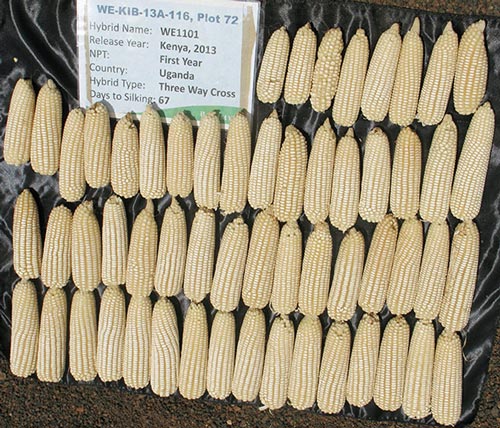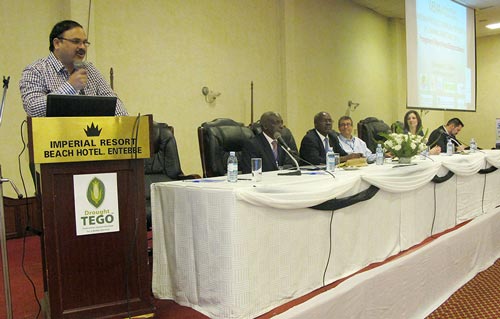By Wandera Ojanji/CIMMYT
The Water Efficient Maize for Africa (WEMA) project is on-track to produce and distribute at least 25 drought-tolerant maize hybrids for farmers in Kenya, Mozambique, South Africa, Tanzania and Uganda during its second phase.
In 2013, the project commercially released 15 drought-tolerant maize hybrids, with 84 more nominated for national performance trials. “This is a rare feat,” said Sylvester Oikeh, WEMA project manager, during the project’s Sixth Annual Review and Planning meeting from 7 to13 February. “In the history of maize research in Africa, only one entity – WEMA – has released 15 hybrids in a single year.”

At its inception in 2008, WEMA promised to develop and deploy maize varieties that would not only tolerate moderate drought but also provide 20 to 35 percent more grain yield than currently available commercial hybrids. Buoyed by the success of the breeding pipelines in Phase I (2008-2013), the partnership set the 25-hybrid target in February 2013 for Phase II (2013-2017).
Also in 2013, WEMA helped smallholder farmers harvest the drought-tolerant maize variety WE1101, sold under the brand name DroughtTEGO™, said Denis Kyetere, executive director of the African Agricultural Technology Foundation (AATF). The hybrid recorded impressive sales in Kenya, according to Gospel Omanya, AATF’s seed systems manager and WEMA deployment team leader. From September 2013 to January 2014, farmers purchased 42.5 tons of the 72 total tons of seed distributed to seed companies. Omanya expects additional sales and adoption of the hybrid, due to its outstanding performance – an average yield of 4.5 tons per hectare (t/ha) during the short rain season, compared to Kenya’s average maize yield of 1.8 t/ha. WE1101 is one of the hybrids developed using breeding lines from the Drought Tolerant Maize for Africa (DTMA) project. Natalie DiNicola, vice president for Europe and Africa for Monsanto, lauded WEMA partners for the achievement. “Thank you for making it happen, for getting the products into the hands of farmers,” DiNicola said.
Uganda Minister of State for Agriculture Nyiira Zerubabel also praised the progress. “Your effort in addressing maize production constraints and increasing productivity levels are highly commendable,” stated Nyiira in a speech read on his behalf by Okaasai Opolot, Uganda’s director of crop resources, during the official opening of the meeting. He urged the project partners to deliver a holistic package to the farmers. “Your work should ensure that the varieties you develop achieve the expected performance that delivers high quantities and qualities by addressing these issues: good crop and post-harvest management practices and productivity, access to markets for rural farmers, efficient seed systems to boost productivity, and value addition initiatives that will improve rural incomes.”
Participants experienced the best of WEMA breeding and testing in Uganda when they visited Namulonge Research Station, where confined field trials of MON810 and other WEMA conventional hybrids are under way. Lawrence Kent, senior program officer of agriculture, science and technology for the Bill & Melinda Gates Foundation, urged WEMA partners to aim for higher impact over the next four years. “We must generate and reach more farmers with products. I am excited about the promising MON810 results so far and I urge you to seize the opportunity and forge ahead with commercializing it and making it available to needy farmers.”

B.M. Prasanna, director of CIMMYT’s global maize program, noted that maize lethal necrosis (MLN) disease had serious consequences on seed production and delivery and crop production in 2013. “Seed shipments were restricted,” said Prasanna, “and maize cultivation was shut down in affected areas, limiting seed production and breeding activities.” At the same time, said Prasanna, the MLN threat is an opportunity to replace old varieties on the market with higher-yielding, resistant ones. More than 2,000 maize lines were screened under natural infections of MLN in two seasons in Kenya during 2013. “We found clear-cut responses and identified some very promising resistance,” Prasanna said.
He added that the resistance would be speedily incorporated into breeding lines and populations through screening at the MLN facility in Naivasha and use of the doubled haploid facility in Kiboko, both inaugurated in March 2013. Partners are also following protocols circulated by CIMMYT to ensure the pathogen-free production and exchange of maize breeding materials. The WEMA advisory board has recommended that the project intensify the breeding of conventional maize varieties for Mozambique and Tanzania, engage large seed companies to use WEMA products, develop exclusive licensing for current products and encourage governments to facilitate trials of transgenic maize.
WEMA Phase II is funded by the Bill & Melinda Gates Foundation, the U.S. Agency for International Development (USAID) and the Howard G. Buffett Foundation.
 Climate adaptation and mitigation
Climate adaptation and mitigation